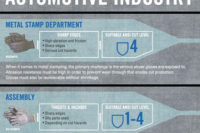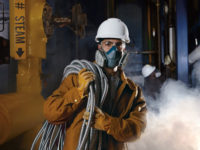
OSHA’s Personal Protective Equipment (PPE) Standard (29 CFR 1910.132 for General Industry) has been in place for more than a decade and remains the primary regulation governing your PPE program. General requirements of the PPE Standard cover four major activities: (1) assessment, (2) selection, (3) training, and (4) verification. Note that each activity requires a different skill set. Line managers should designate leaders whose abilities are aligned with the requirements of each of these activities; it may not be the same person for each step.
We will explore these four activities and highlight what you need to know to adhere to the PPE Standard and provide a safer and healthier workplace.
1) Assessment — Understand the environment
Hazard assessment is arguably the most important step in PPE compliance, because it is the basis from which the entire PPE program is built. You have to be both open-minded and realistic during this phase of the process and understand the significance of each hazard faced in your work environment.
Responsibility for performing the hazard assessment should not fall solely on one person or even one part of the organization. Collaboration is more likely to result in proper identification and assessment of hazards. A contributor with independence and detachment from day-to-day operational responsibilities helps avoid inherent conflicts between current practice, production and cost pressures, hazard potentials and best practice.
2) Selection — Match PPE to the hazards
Before you select your PPE, first decide if PPE is the proper and only solution. As OSHA points out in the compliance guidance to this regulation, you shouldn’t rely on PPE devices alone to provide protection against hazards, but PPE should be used in conjunction with guards, engineering controls and sound manufacturing practices.
Ask the following questions:
• Can the hazard be removed by substitution or elimination of an ingredient or task?
• Can the hazard be mitigated by guards or redesign of the equipment?
• Can work practices, procedures or administrative controls be put in place to abate the problem?
This approach of mitigating the need for PPE is becoming more the rule than a suggestion with OSHA. In the recently passed Chromium VI regulations, OSHA requires use of engineering controls and work practices, where feasible, to abate the hazards, instead of immediately relying on PPE to protect against hazards.
Even with the implementation of engineering controls, work practices and administrative controls, the need for PPE is still likely. Respirators are highly prescribed. There is clear guidance and requirements for eyewear, gloves and footwear. However, the process of selecting PPE clothing requires considerable skill because it is the least specified set of regulations under the OSHA PPE standards.
Rules and guidance for selecting protective clothing are more general due to the broad range of potential hazards that protective clothing addresses, including heat, flame, arc, and exposures to toxic solids, vapors, liquids, aerosols and bloodborne pathogens. Even when PPE is discussed in regulations dealing with hazards such as asbestos, lead, hazardous waste and emergency operations, fire brigades, electrical workers and bloodborne pathogens, the specific requirements and selection guidance are vague.
With chemical and biological protective clothing, the fundamental decisions are fabric, seams and design. These are governed by questions such as:
• What is the probability of actual contact?
• What is the likely amount of contact?
• What is the expected duration of contact?
• From what direction is the contact likely?
When focused on the primary chemical or biological hazards, the selection process must also consider other hazards such as flammable or explosive atmospheres, hot or cold temperatures, physical hazards, punctures, abrasions, pinch or grab/snag hazards, slipping, falling and visibility — in terms of both seeing and being seen.
OSHA requires that PPE be provided, used and maintained in a sanitary and reliable manner. This leads to a decision between disposable, limited-use or reusable options. In the case of chemical and biological protective clothing, “sanitary and reliable” can be interpreted as knowing that the item has been decontaminated sufficiently to remove the hazard and not damaged by the prior exposure or decontamination process.
3) Training — Proper wear, care and disposal
Once the appropriate PPE is selected for the work environment, the employer must communicate that decision to affected employees. Then, workers must be properly sized and trained.
Training starts with ensuring that employees know what PPE is required and when. Training must include how to don, doff, adjust and wear PPE. This is a good time to confirm sizing. Relying on sizing charts is not enough. How well a garment fits can be impacted by the type of job, whether additional PPE is worn over or under the garment, and the size and shape of the wearer. Employees should not only try on PPE, but also do simulated work activities to test the fit. Where size is concerned, too big is as bad as too little. Too big may cause tripping or movement hazards as well as opportunities for snags, rips or tears.
Training must also cover the limitations of PPE, proper care and maintenance, useful life and disposal of PPE. In the case of chemical and biological protective clothing, understanding the proper disposal method may require dealing with the exposed garment as a hazardous material itself.
4) Verification — Maintain compliance
For the final step, employers must verify that employees know, understand and follow their PPE training. Employers must retrain an employee if there is a change in work assignment, change in PPE or if improper use is detected. This verification process can be accomplished through a physical or paper audit (e.g., questionnaire). Unlike Hazcom training, auditing activities are not required annually. However, it is good practice to couple PPE auditing with the mandated Hazcom training to ensure the PPE program is still effective and that employees are using the equipment in the proper manner.
Most PPE devices are not intended to be the only measure of protection against hazards. When PPE is required, employers must understand that compliance is a detailed process.



